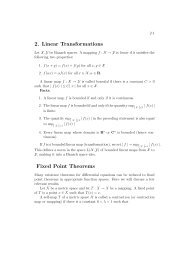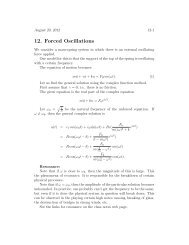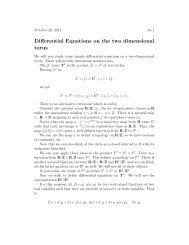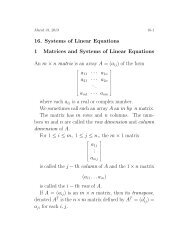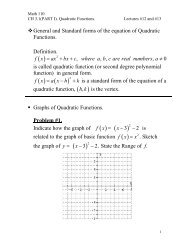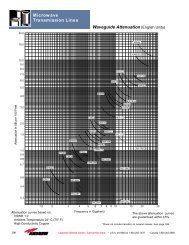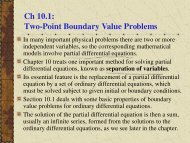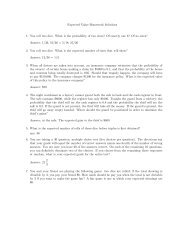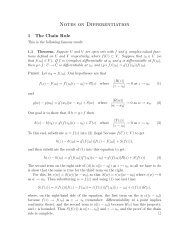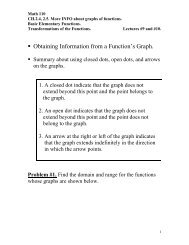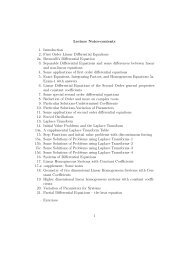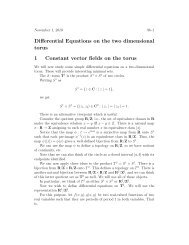Since f is analytic on Ω, both integrands on the right sides of these equations vanish identicallyon Ω, hence the integrals are zero. This completes the proof.□Example 3. Suppose γ is the unit circle and p a complex number of modulus > 1.∫dzThen:z − p = 0.γProof. Apply the result above with f(z) = 1/(z − p), Ω = {z : |z| < 1}, Γ = γ. Then f isanalytic on a disc slightly bigger than the unit disc that doesn’t contain the point p, say inthe disc of radius (1 + |p|)/2, so the hypotheses of the above result are satisfied, hence so isthe conclusion.□4. The Cauchy Integral <strong>Theorem</strong>. Suppose D is a plane domain and f a complex-valuedfunction that is analytic on D (with f ′ continuous ∫ on D). Suppose γ is a simple closed curvein D whose inside 3 lies entirely in D. Then: f(z) dz = 0.Proof. Apply the “serious application” of Green’s <strong>Theorem</strong> to the special case Ω = the insideof γ, Γ = γ, taking the open set containing Ω and Γ to be D.□The Cauchy Integral <strong>Formula</strong> Suppose f is analytic on a domain D (with f ′ continuouson D), and γ is a simple, closed, piecewise smooth curve whose whose inside also lies in D.Then for every point p inside of γ:f(p) = 12πiProof. Fix p lying inside γ, and let ε be anypositive number small enough so that the discdef∆ ɛ = {z : |z − p| < ε} lies entirely inside of γ. 4Let γ ε be the positively oriented boundary of ∆ ε .Let Ω ε be the domain that lies between γ and γ ε .∫γγf(z)z − p dz.Note that the positively oriented boundary Γ ε of Ω ε is γ − γ ε , and that the functiong(z) def= f(z)z − p(ζ ∈ D\{p})is analytic on D\{p}. Now apply the “serious application” of Green’s <strong>Theorem</strong> proved inthe last section to g, with D\{p} playing the role of “the open set containing Ω and Γ.” Theresult is:∫ ∫∫ ∫0 = g(z) dz = g(z) dz = g(z) dz − g(z) dz,Γγ−γ ε γγ ε3 Recall the Jordan Curve <strong>Theorem</strong> (pp. 56-57): If γ is a simple closed curve in the plane, then thecomplement of γ consists of two disjoint open sets, one of which, called the outside of γ, is unbounded, whilethe other, called the inside of γ, is bounded.4
sothat is:(3)∫∫γγ∫g(z) dz = g(z) dz,γ ε∫f(z)z − p dz =γ εf(z)z − p dzLet’s reduce the right-hand side of (3) to an integral over the real interval [0, 2π] by thecomplex parameterization z = γ ε (t) = p + εe it , 0 ≤ t ≤ 2π. Then dz = iεe it dt andz − p = εe it , so(4)∫γ ε∫f(z)2πz − p dz =0f(p + εe it )εe it∫ 2πiεe it dt = i f(p + εe it ) dt0Being differentiable on Ω, f is continuous there. In particular, f(p + εe it ) → f(p) as ε → 0,hence(5)as ε → 0. 5∫ 2π0f(p + εe it ) dt →∫ 2π0f(p) dt = 2πf(p)Now on both sides of (3), take the limit as ε → 0. The left-hand side does not depend on ε,and on the right we use (4) and (5). The result is:∫f(z)dz = 2πi f(p)z − pγas promised.□Example 4. Let γ be any simple closed curve in the plane, oriented positively, and p a pointnot on γ. Then:∫γ1z − p dz =⎧⎨⎩2πiif p is inside of γ0 if p is outside of γProof. The result for p inside γ is just Cauchy’sformula for f ≡ 1, while for p outside of γ thefunction f(z)/(z −p) is an analytic function (of z)on an open set Ω containing both γ and its insideregion. Thus the integral is zero by the Cauchy<strong>Theorem</strong>.□5 Here we’ve interchanged the limit, as ε → 0, with the integral. This requires a separate argument, whichwe’ll skip.5



